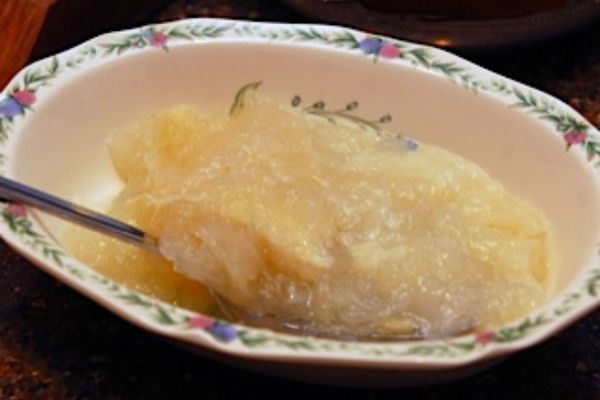lutefisk: the ghost of christmas past
As you scour the web to learn more about Lutefisk you’re going to see beautiful photos of the same fish, served with roasted potatoes and some kind of green pea puree (I’m guessing).
What you see below folks, is actually Lutefisk. You should see the look of horror on my friends’ faces when they take a bite. It looks like applesauce after all. Definitely doesn’t taste like it.
“It’s not Christmas until we have Lutefisk.”
My dad says those words every year, without fail.
In fact, it’s not Christmas until my dad says the thing about the Lutefisk.
My people (on my dad’s side) are Scandinavian, and Lutefisk has been part of our holiday feast tradition since the Viking Age.

How Lutefisk Is Made
Lutefisk comes from the Old Norse, meaning, Do you feel lucky?
Lutefisk is a Scandinavian delicacy, which we all know is code for “wow, does this suck”. In fact, behind the beautiful Northern Lights and scary-looking Viking dudes, Lutefisk might be one of the most known things from the region.
Lutefisk is cod fish that’s been hung on racks and dried in the open air until it resembles fish jerky. But it’s not done yet.
You might chip a tooth on cod jerky, so you have to soften it up a bit before you can eat it.
So, you reconstitute the cod in lye (yes, the same lye used to make soap, declog drains, and clean ovens).
As your cod soaks in its lye bath, it starts to gelatinize. And, tiny detail — it’s also poisonous.
To make it edible again, it must be rinsed and soaked in water (that you constantly change) for four to six days.
Four is probably death, so I’d go with six.
How To Cook Lutefisk
Now that your Lutefisk is technically edible, you need to cook it.
Back in St. Olaf, you cooked your lutefisk in big enamel pots in your kitchen.
And because few smells are more offensive than Lutefisk boiling on the stovetop, this is an outstanding way to clear the house of any holiday company that’s on your last good nerve.
Is it really that bad, you ask?
Lutefisk will singe your nose hairs — it smells like a dead fish wrapped in a sweaty sock left to ferment in a teenage boy’s bedroom. Mmmm, Mmmm.
But Lutefisk has evolved. Now, you can buy Lutefisk in hermetically sealed, microwaveable plastic packages that (more or less) contain the smell.
It’s skinless! Right, because it’s the skin that would make the dish unappealing.
Lutefisk Hotline
If you’re dying to try Lutefisk, you can call the Lutefisk Hotline (I am not making this up) at the Olsen Fish Company in Minneapolis.
The Lutefisk will ship to you packed in dry ice. Just be sure you’re not out of town when it arrives.
Lutefisk that sits on your front step for 3 days reverts to poisonous.
Been there. Done that.
The finished Lutefisk has the consistency of Jell-O.
Beige (sometimes gray), fish-flavored Jell-O. Lutefisk is served over boiled potatoes and covered in a white sauce.
Tip: don’t ever serve or eat your Lutefisk with Grandma’s Inga’s sterling silver. The Lutefisk will permanently ruin sterling silver.
Yes, you read that right. Lutefisk will destroy metal alloys, but don’t let that deter you from eating it. Dig in!
The History Of Lutefisk
Who do we have to blame for Lutefisk?
There are a bunch of stories that float around, but my favorite one says Lutefisk is St. Patrick’s fault.
Once upon a time, Viking raiders were pillaging Ireland (as Vikings do), and St. Patrick thought he’d teach those pesky Vikings a lesson.
So he attempted to poison the Vikings by covering their fish stores with lye. That’ll teach ’em.
When the Vikings discovered the fish, they dug in (didn’t die) and declared it a delicacy.
It’s a good story, until I ruin it for you and tell you St. Patrick died centuries before the Vikings started plundering northern Europe.
Lutefisk is a dying tradition — today, more Lutefisk is consumed in Wisconsin than Scandinavia.
And now that I’m a grown up, I for sure don’t have Lutefisk on my Christmas table (sorry, dad).
There are many other (delicious) ways I can stay connected to my Nordic heritage. Ostakaka (a Swedish almond cheesecake with an unfortunate name) will always have a place at my holiday table.
On the years we spend Christmas with my family, Lutefisk is a constant, even comforting presence. It’s comforting because I know these words are coming:
It’s not Christmas until we have Lutefisk.
To humor my dad, and appease the Norse Gods, I have one (and only one) ceremonial bite of Lutefisk.
Honestly, it doesn’t taste like much of anything (other than regret) . . . it’s the texture that will kill you.
Oysters and slugs have nothing on lutefisk. Lutefisk is almost impossible to swallow, because it tries to crawl back up your throat.
Eating a bite of Lutefisk comes down to mind over matter. Here I am . . . making my mind right. Please stay down. Please stay down. Please stay down.
Lutefisk Wine Pairing
And what does Lutefisk have to do with wine? Uff-Da!!
Have you ever tried to pair a wine (any wine) with poisonous soap fish? I
t’s no easy task. We’ve tried Lutefisk with scads of wines over the years.
Red wine and Lutefisk is an abomination.
Champagne and Lutefisk is a waste of Bubbles.
And white wine and Lutefisk is merely a distraction.
The best strategy is to flank the Lutefisk with wine. Drink a bottle of wine before you eat your Lutefisk, and another bottle or three after.
Or . . . you could go native and have your Lutefisk with Aqavit!
As I write this, my mom and dad are in Germany. My mom tried to call The Lutefisk Hotline several times before she left, but no one is answering. Oh no! What if there’s a Lutefisk shortage?!? No, no, no. Pick up the phone! Pick up the phone!!
I’d love to hear about your family holiday traditions. So finish this sentence: It’s not Christmas/Hanukkah/Festivus until ____________________.
Lutefisk FAQ
What does Lutefisk taste like?
Lutefisk tastes like fish flavored Jell-O. It’s cod fish that’s been hung on racks and dried in the open air until it resembles fish jerky. Then, you reconstitute the cod in lye to gelatinize it. And, tiny detail — it’s also poisonous. To make it edible again, it must be rinsed and soaked in water (that you constantly change) for four to six days. Four is probably death, so I’d go with six.
Is lutefisk still soaked in lye?
Yes, Lutefisk is soaked in a lye bath after it’s been dried to become edible. Since lye is poisonous you need to then rinse it 6 times, constantly changing its bath. Mmmmm. Hungry yet?
What is the point of Lutefisk?
Lutefisk is a Scandinavian Christmas tradition. One that will not survive this generation.
Why do they use lye in lutefisk?
The lye breaks down the protein in the fish to make it edible and tolerated by your small intestines. This is how lutefisk acquires jelly-like texture.
Why do people like lutefisk?
No one enjoys eating Lutefisk. But… it’s tradition. Remembering the protein that sustained our ancestors in long winter months is worth preserving.









